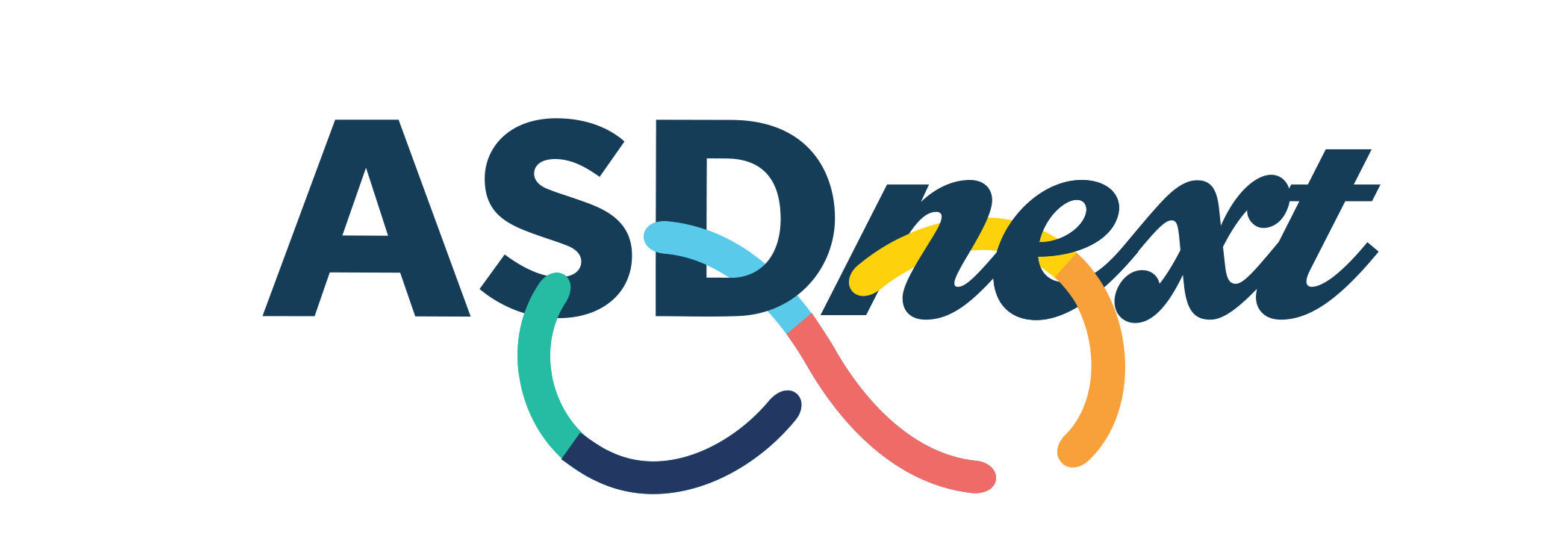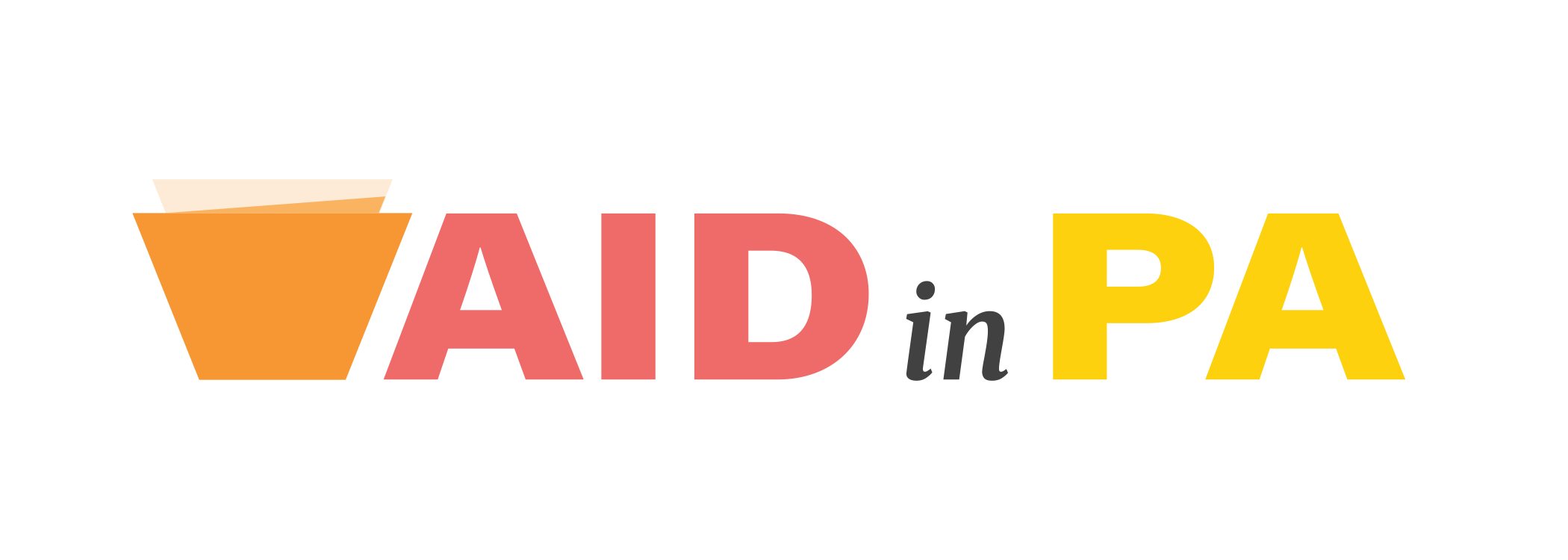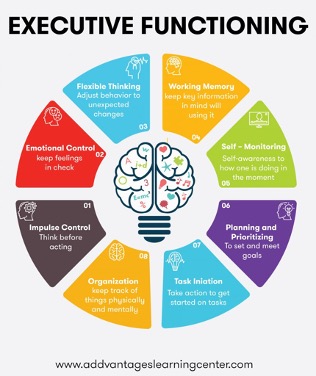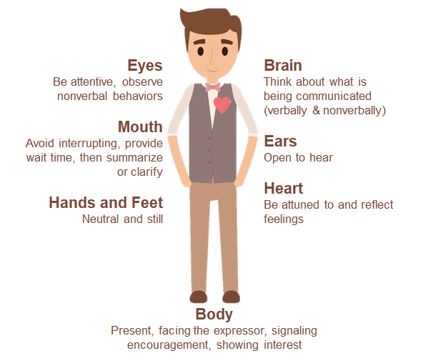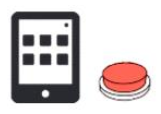Communication Corner - Archive

Communication Corner
![]()
Did you know language development and executive functioning skills are related to each other in important ways?
They have a reciprocal relationship, meaning each relies on the other for optimal growth. Language processing recruits many executive functioning skills.
Here’s a reminder about executive functioning-
If someone you support has impaired communication, it’s likely they will have executive functioning deficits because of the correlation between them.
So what?
You may be frustrated that the person you support always grabs the item you have. Or maybe you don’t understand why their emotions are all over the place. If you’re aware of this connection, you can be understanding of their skill deficits and find increased patience, as well as strategies to improve not only their communication but in turn their executive functioning skills!
J Child Psychol Psychiatry. 2016 Feb; 57(2): 180–187.
Posted December 2021
Language vs. Communication
Do you use these terms interchangeably?
Using language may be a way to communication but communication
is so much more than using language.
|
Language |
Communication |
|
The system of communication |
The way of exchanging a message or information from one person to another |
|
Relies on verbal or non-verbal codes |
Process |
|
Used in transferring information |
Sending of a message |
|
Tool of communication |
|
For more information on the Communication Corner, please contact the Special Populations Unit at
Posted November 2021
Try this not that!
Instead of pretending to understand what the person you support is communicating…
Try:
Expressing you’re interested in figuring out what they’re communicating by making eye contact and responding to their communication attempts
Encouraging them to show you or use gestures
Guessing based on context clues
Reiterating any parts you understood to build their confidence
Being sincere when frustration sets in
“Assuming competence for any person, whether they have a
disability or not, is a form of empowerment.”
-Becca Eisenberg
Posted September 2021
DeafBlind Awareness Week was June 27th - July 3rd
Do you support someone who is DeafBlind?
Before answering no, check out the info below… you may be surprised!
DeafBlind doesn’t mean fully deaf and fully blind. It’s a spectrum and can be any combination of both hearing and vision loss.
|
|
Normal Hearing |
Hard of Hearing (mild to moderate) |
Deaf (severe to profound) |
Progressive Loss |
|
Normal Vision |
|
Hearing Loss |
Hearing Loss |
Hearing Loss |
|
Low Vision |
Visually Impaired |
DeafBlind |
DeafBlind |
DeafBlind |
|
Legally Blind |
Visually Impaired |
DeafBlind |
DeafBlind |
DeafBlind |
|
Progressive Loss |
Visually Impaired |
DeafBlind |
DeafBlind |
DeafBlind |
DeafBlindness is a disability of access- to the environment, people, objects, materials, experiences, etc. that are necessary for learning, communication, and development.
You can support someone with combined vision and hearing loss in a variety of ways:
Use the individual’s strongest sense to communicate with them
Support them through hand-under-hand instead of hand-over-hand
Create routines and invite them to participate in them
Maximize visual and auditory access
Follow the individual’s lead
Want more information about DeafBlindness? Watch DeafBlindness101 here!
“It is important to understand that the [person’s] vision and hearing losses are not additive in nature (deafness plus blindness), but rather are multiplicative (deafness times blindness). Therefore sometimes even [people] with seemingly mild simultaneous vision and hearing losses can be greatly impacted by them.”
-Huebner, Prickett, Welch, & Joffee
Posted July 2021
June is Effective Communication Month!
“Every person has an effective way to communicate in order to express choice and ensure his or her health and safety. All forms of communication should consider and include the individual’s language preferences and use of current technology.”
- ISAC Recommendation #1
Can the individuals you support effectively communicate?
Do the people you support have a reliable way of communicating “yes” and “no”? Are they adapting their communication to fit the team or is the team communicating with them in a way that makes sense to them?
Here are some communication tips!
- When the individual makes any purposeful movements, vocalizations, or facial expressions, immediately acknowledge what they did, and respond with what they may be trying to communicate.
- Instead of swooping in right away to fix little problems (picking a dropped item off the floor for them, getting them an item from the fridge before it’s asked for), anticipate their need, but wait and see what they will do or say, creating an opportunity for them to communicate that something has gone wrong or that they need help.
- While going about your daily tasks, responsibilities, and activities, narrate them in a way that can be understood by the individual - even if they don’t involve the individuals you support. This allows the individual to “overhear” additional communication that they may not typically be exposed to.
For more information about the stages of communication, check out this article!
For more information on the Communication Corner, please contact the Special Populations Unit at RA-ODPDeafServices@pa.gov.
Posted June 2021
![]()
Try this communication technique:
Communication Temptations
What are Communication Temptations?
A strategy where you structure the environment in such a way that the individual has to use spontaneous communication with another person to get a desired item/result.
Example: Not putting ketchup (their favorite!) with breakfast so they have to seek it out by communicating about it with someone.
Why are Communication Temptations useful?
They provide the individual with both a reason and opportunity to communicate with another person. It’s an opportunity to initiate communication in some form.
When are Communication Temptations useful?
They can be used in almost any situation, especially in daily routines!
How do I use Communication Temptations with someone I support?
Think about what motivates that individual; what are the “desirable items” or things you can use that will encourage them to initiate communication? This could look like giving the individual their snack but “forgetting” to open it or putting a desired item in view, but out of reach or in a harder to access spot.
For more information on the Communication Corner, please contact the Special Populations Unit at RA-ODPDeafServices@pa.gov.
Posted May, 2021
![]()
Communication Access Real Time
Why Should I use it?
To provide access for someone who is Deaf and prefers captions or someone who is hard of hearing
Individuals with autism may process or produce language at a different rate and may have difficulty understanding metaphors and sarcasm in conversations. Being able to read the words as well as hear them is helpful and may help the individual understand the dialogue better.
Some individuals find it difficult to follow complex conversations or decode speech when there’s a lot of background noise. For this reason, some individuals with autism may wear noise-canceling headphones. With captions, those individuals would not have to remove their headphones to participate.
Some complex communicators may ‘listen’ and participate better when they can match the spoken words, they hear to words they can see on a screen.
For individuals with auditory processing disorder, they may develop listening fatigue that may inhibit their understanding and limit their participation. Captions would give the person opportunities to participate visually as well.
Captions also help maintain concentration, which can provide a better experience for viewers with learning disabilities or attention deficits.
Studies have shown that individuals with Down syndrome have poor auditory short-term memory, meaning they don’t always remember what they just heard. Using a visual element like captions may help improve this.
For individuals that speak English as a second language (ESL) or are English language learners (ELL), captions can provide some helpful context, encouraging the individual to stay further engaged. Accents and dialects are another reason why captions can be beneficial.
Posted April, 2021
![]()
What is Communication Access Real Time (CART)?
CART is the instant translation of the spoken word into English text. The text produced by the CART service can then be displayed on an individual’s computer, projected, or appear as captions for a video presentation (example: meetings in Zoom).
Posted March, 2021
![]()
Supporting Individuals with Limited English Proficiency (LEP)
What is LEP?
It is defined as a limited ability to read, write, speak, or understand English because English is not the individual’s primary language.
Over 1,900 individuals supported in the ODP system have a language other than English listed as their primary, preferred language.
How do we support these individuals? Here are some tips!
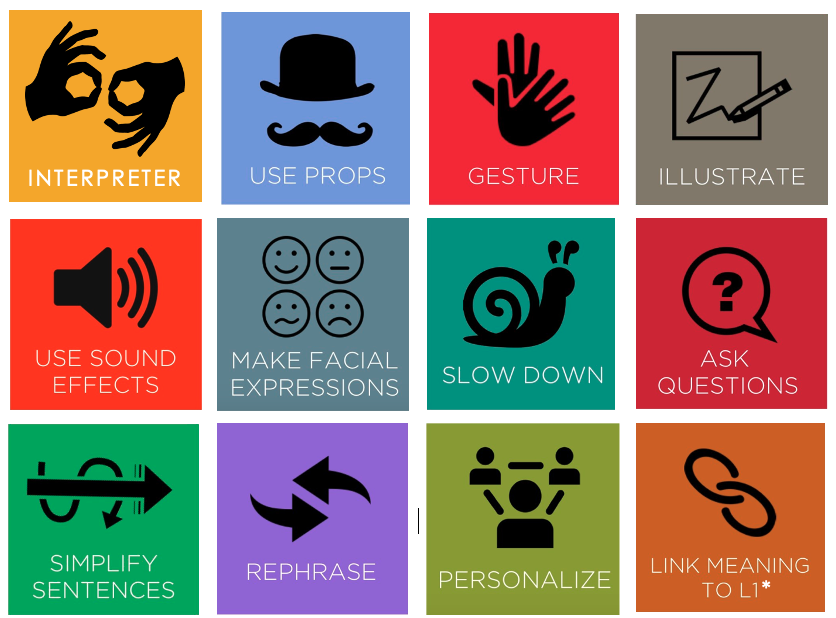
Resource: Comprehensible Classroom *L1 refers to an individual’s first language
Join us on February 26th at 1pm for our LEP 101 Training!
*An ASL interpreter will be present during the presentation
For more information on the Communication Corner, please contact the Special Populations Unit at
Posted February 2021
![]()
Communication and… Series
ODP is happy to announce the publication of the Communication and… Series with over 25 different diagnoses included!
What’s the purpose?
The goal of this series is to provide information on how each diagnosis could impact communication and offer strategies to support effective communication.
Which diagnoses are covered?
|
■ Alzheimer’s Disease |
■ Cornelia de Lange Syndrome |
■ Reactive Attachment Disorder |
|
■ Angelman Syndrome |
■ Cortical Visual Impairment |
■ Rett Syndrome |
|
■ Apraxia of Speech |
■ Deaf-Blindness |
■ Schizophrenia |
|
■ Attention Deficit Hyperactivity Disorder |
■ Fetal Alcohol Spectrum Disorder |
■ Sensory Processing Disorder |
|
■ Autism Spectrum Disorder |
■ Hearing Loss |
■ Stroke |
|
■ Cerebral Palsy |
■ Huntington’s Disease |
■ Traumatic Brain Injury |
|
■ CHARGE Syndrome |
■ Language Deprivation |
■ Usher Syndrome |
|
■ Communication Disorder |
■ Parkinson’s Disease |
■ Visual Impairment |
|
■ Conduct Disorder |
||
This series can be found on MyODP.org under
Trainings > Special Populations > Infographics.
Posted January 2021
![]()
ODP is happy to announce the publication of our first online Visual Gestural Communication (VGC) training module!
What is VGC?
A method of communication that provides a means of bypassing vocabulary and strict grammar rules of a language. It is a mode of communication that involves gestures, facial expression, and body language use and analysis.
Over 8,000 individuals supported in the ODP system have VGC listed as their primary mode of communication. This is the first module of many to come and will serve as a prerequisite to the other modules.
Topics covered include:
⦁ The basics of VGC
⦁ How to apply VGC,
⦁ Supplementary tools
⦁ Lots of videos and visual examples
This module can be found here or on MyODP.org under
Trainings > Special Populations > Non-traditional Communication.
*Please note: closed captioning and transcription provided
Posted December, 2020
![]()
CHECK THIS OUT!
Are we listening? The Challenges and Opportunities in Communication
This issue was created to inform and educate readers on the many forms of communication and how best to use these methods to ensure individuals are given every opportunity to reach out, connect, and find their place in the community living an everyday life.
There are 8 different articles touching on a variety of topics:
· A mother’s trials and victories supporting her son with deaf-blindness
· Data discoveries surrounding communication assessments
· Tips and strategies to support those without formal communication
· Information about language dysfluency and its impact
· The challenges surrounding those in the disability community with limited English proficiencies
SO much more!!
This issue of Positive Approaches Journal is in digital format, available for viewing online or for downloading at:
For more information on the Communication
Corner, please contact the Special Populations Unit at
Tips for Supplementing Communication While Wearing a Face Mask
Covering the majority of the face can make it difficult to convey emotion and communicate with others. It is important to be conscious of the communication that is lost while wearing a face mask. Below are some tips to supplement communication. Try different tips based on the needs of the person you are interacting with.
Be patient
Get the other person’s attention before speaking
Make eye contact, if possible
Use context clues within the situation
Take off sunglasses and hats to allow the other person better access to your face
Ensure adequate lighting
Be aware of your environment – Move away from noises and distractions, if possible
Speak louder – Masks tend to muffle sound
Use short, simple sentences
Speak face-to-face and at eye level
Clarify if you are unsure what the other person is saying
Use gestures or real-life objects – Wave, point, give thumbs-up, and so on to reinforce what you’re saying
Use your body language to accentuate your emotions – Such as head tilts, head nods, and your posture
Be aware of and use your eye brows to emphasize communication
Write it down if you need to – Thicker dark letters on white paper are more easily seen from 6 feet away
Use some sign language that is commonly known such as thank you, please, and sorry
Use a clear face mask!
Posted 9/21/2020 2:34 PM
![]()
Tips for supporting those transitioning back to school:
1. Plan for a transition well before it occurs.
Talk about the differences with this school year well in advance. By communicating about these changes prior to them occurring, it allows extra time for processing and understanding.
2. Make the transition visual with a schedule
Schedules are a great visual tool to help make time and changes more tangible. Show that school will begin by placing a picture of the school on a calendar and crossing off the days until it arrives. If school is virtual, you can use a task schedule to help students stay focused and visually grasp each individual task.
3. Utilize social stories
Social stories can be used as a visual preview to new or unfamiliar experiences. Often, they also highlight potential feelings that may occur during these new experiences. There are a variety of great social stories available here.
4. Read picture books
Picture books are a great tool to make abstract ideas more concrete through simple words and images. This resource has many free books about varying topics for all ages that can be viewed online or printed and read.
5. Role play and model
School may look very different this year than in previous years. If masks are required, model the use of a mask yourself or use their favorite stuffed animal. Act out some of the differences that may occur, allowing them to make sense of the changes in a comfortable environment through this role play.
For more information on the Communication Corner, please contact the Special Populations Unit at RA-ODPDeafServices@pa.gov
Posted: August 18, 2020, 12:08
![]()
How do I create a visual schedule?
Reminder:
A visual schedule is a representation of scheduled tasks or activities in the order in which they’ll occur using symbols, objects, pictures, and/or words.
Visual schedules need to be created fully based on
the person’s unique skills and needs.
How:
1. Decide on a format together
Select symbols that will make sense to the individual (something they experience and will recognize) and decide if you’re setting up a daily, weekly, or monthly schedule for them to utilize.
2. Less is more
In the beginning, don’t overwhelm the person with a full schedule, creating a symbol for every aspect of their day. Start with less and allow them to get used to using it before increasing the number of symbols used.
3. Consider their transitions, preferences, and moments that happen often
When choosing the first few symbols to start with, think about the person’s biggest transitions throughout their day (example: leaving the house to go to their day program). Also, consider their favorite parts of their days and routines that occur most often (example: meal time). The more they interact with the schedule, the faster they’ll understand its purpose and function.
Additional tips:
-
Real pictures (instead of cartoons) may be easier for the person to understand.
-
If they’re uncomfortable interacting with the schedule, model how to use it.
-
Using it consistently is key!
The Special Populations Unit is hosting a webinar all about visual schedules during the month of July. Keep an eye out for this training!
For more information on the Communication Corner, please contact the Special Populations Unit at RA-ODPDeafServices@pa.gov
Posted: June 10, 2020, 15:50
![]()
Using a visual schedule could be a game-changer!
What is a visual schedule?
It is a visual representation of scheduled tasks or activities in the order in which they’ll occur, using symbols, objects, pictures, and/or words.
Why use a visual schedule?
- Facilitates communication (both expressive and receptive)
- Supports the concept of sequencing
- Creates smoother transitions
- Fosters independence
- Reinforces the beginning and end of activities
- Individualized to meet the person’s needs
- Provides clear directions in a way that makes sense to the person
- Keeps individuals on task
What does a visual schedule look like?
It could look very differently depending on the needs of the individual you support. Visual schedules need to be created fully based on the person’s unique skills and needs. Tune in next month for some easy steps to create a visual schedule or email us to get started sooner!
![]()
For more information on the Communication Corner, please contact the Special Populations Unit at RA-ODPDeafServices@pa.gov
Posted: May 1, 2020, 11:25
![]()
April is World Autism Awareness and Acceptance Month
Behavior IS communication
All behavior is a form of communication and all behavior serves a purpose. This means that sometimes when people don’t have an effective way to express their needs, they may use behaviors to get what they want or need. Observe patterns and changes of a person to determine what it is they may be trying to communicate.
Especially in light of COVID-19, there may be a shift in people’s mannerisms or increase in repetitive behaviors that may indicate the person is experiencing heightened anxiety. A sudden stop of activities they typically enjoyed at home may indicate signs of sadness or depression.
Listen to their behaviors!
Help manage these changes for someone who thrives on routines and schedules by utilizing social stories or a visual schedule. For more information, check out
https://paautism.org/resource/coronavirus-resources/
|
For more information on the Communication Corner, please contact the Special Populations Unit at |
Posted April 1, 2020 12:02
![]()
Listening is so much more than listening with just our ears! Listening requires our whole body.
By listening with our whole body, we are giving those we support more opportunities to understand and express messages!
For more information on the Communication Corner, please contact the Special Populations Unit at RA-ODPDeafServices@pa.gov
Posted March 02, 2020 08:54
![]() “The responsibility to be understood should not be placed with the person with the communication disability; it is a shared responsibility.”
“The responsibility to be understood should not be placed with the person with the communication disability; it is a shared responsibility.”
Click the link below to read an article that describes simple tools and strategies to support every person to understand, compare and express their preferences as they make decisions.
https://www.assistiveware.com/learn-aac/3-practical-strategies-to-support-choice-control
Posted: January 2, 2020 14:16
![]()
By 18 months, babies have heard 4,380 hours of spoken language and we don’t expect them to be fluent speakers yet.
If Augmentative and Alternative Communication (AAC) learners only see symbols modeled for communication twice weekly for 20-30 minutes, it will take 84 years for them to have the same exposure to aided language as an 18-month-old has to spoken language.
−Speakforyourself.org
If you were teaching French to an individual, this would be done by speaking French. No one would dispute that hearing the new language is an essential prerequisite to learning it. It’s the same with AAC.
If we want the individuals we support to learn to express themselves with AAC, they need significant exposure to others using AAC. For more information please contact the Special Populations Unit at RA-ODPDeafServices@pa.gov
Posted: December 6, 2019 09:12
![]()

